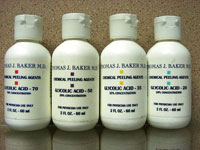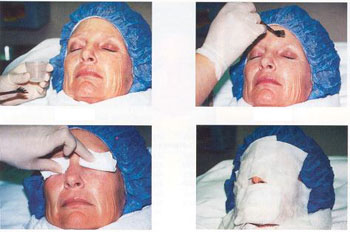Chemical peels use a slightly corrosive chemical to achieved a controlled damage to the epidermis, and let it heals and regenerates. They can be performed on the face, neck or hands. The new, regenerated skin is smoother and more youthful than the old skin.
Overall they can :
- Reduce fine lines and pores
- Improve tone and texture
- Improve mild scarring
- Treat certain types of acne
- Reduce uneven pigmentation, pigmented spots such as freckles and melasma
They can be divided into superficial, medium, and deep peels. Glycolic acid peel is a superficial type and is relatively safe. Medium peel using trichloroacetic acid and deep peel using phenol have a higher risk and is not performed as often. Only glycolic acid peel is described here.
Glycolic Acid Peel
People of any age, and nearly all skin types can have a glycolic acid peel.
As in any other cosmetic treatments being discussed later, during the initial consultation, the doctor will need to understand the concern and expectation, be it the wrinkles, uneven pigmentation or acne scars. Counselling is necessary, particularly the extent of improvement, number of treatments required, and the schedule of treatments.
A detailed health history is necessary, including past and current skin problems, medications, topical treatments, skin care products, and allergy. The facial skin is examined for any active skin problems, such as folliculitis or acne rosecea.
People with auto-immune type skin problems should avoid any chemical peels; people taking blood thinning medication and heavy smokers will have a slower recovery, and People allergic to aspirin (salicylates) should not have a salicylic acid peel. Use of tretinoin at the same time will increase the depth of peel and so the recovery time.
Before the Peel
Any face mask, waxing, electrolysis done within a week may increase the sensitivity to glycolic acid. On the day of peel it is best not to use make up and fragrance, and avoid shaving.
It is better to try using a lower concentration of glycolic acid products at home, to help adapting to the higher concentration used, and it helps to find out the sensitive people.
Choices of Glycolic Acid
Concentrations vary from 20% to 70% can be used. Initially 20% would be tried first, for 2 - 3 minutes. Thereafter the time can be increased stepwise to 5 - 7 minutes before moving on to the next higher concentration. The intervals between peels should be 3 - 4 weeks.

The Peeling Process
A gentle washing to thoroughly remove dirt, oil and sweat, then wrap up the hair with a shower cap and surround the neck with a towel.
The doctor will put some petroleum jelly around delicate areas like the corners of eyes, sides of nose, and corners of mouth, to avoid contact with the acid. Then apply the concentration chosen.
During the process there is a feeling of itch, stinging and burn. Usually it is quite tolerable, but different people have different tolerance and if there is too much discomfort, let the doctor know.
When the time is reached, the eye areas are covered and the face is sprayed or painted with a neutralizer. The face can be rinsed after about 1 minute. A cold compress is put on the face to provide relief. Finally put on a rich moisturizer.

After the Peel
Usually there is no discomfort after the peel. Some may feel a little tight and dry, and there is some redness and skin peeling off for 1 - 3 days, depending on the strength of peels.
It's important to use a broad-spectrum sunscreen, avoid strong sun exposure and make ups, and continue to use moisturizers for 2 - 3 days.

